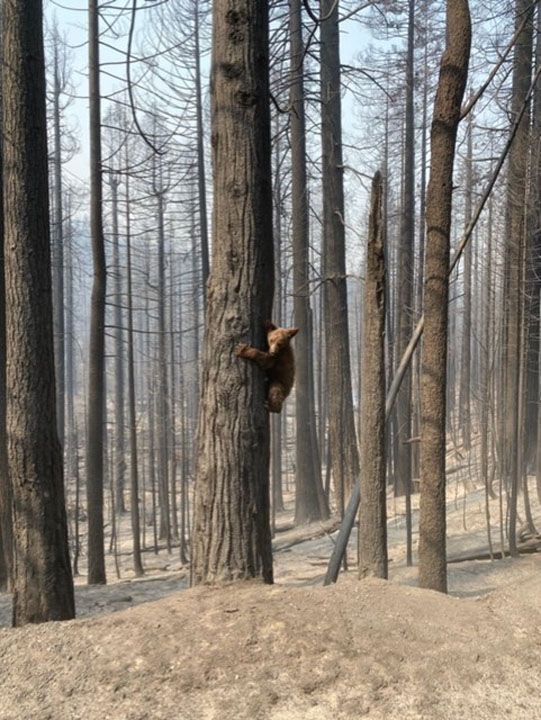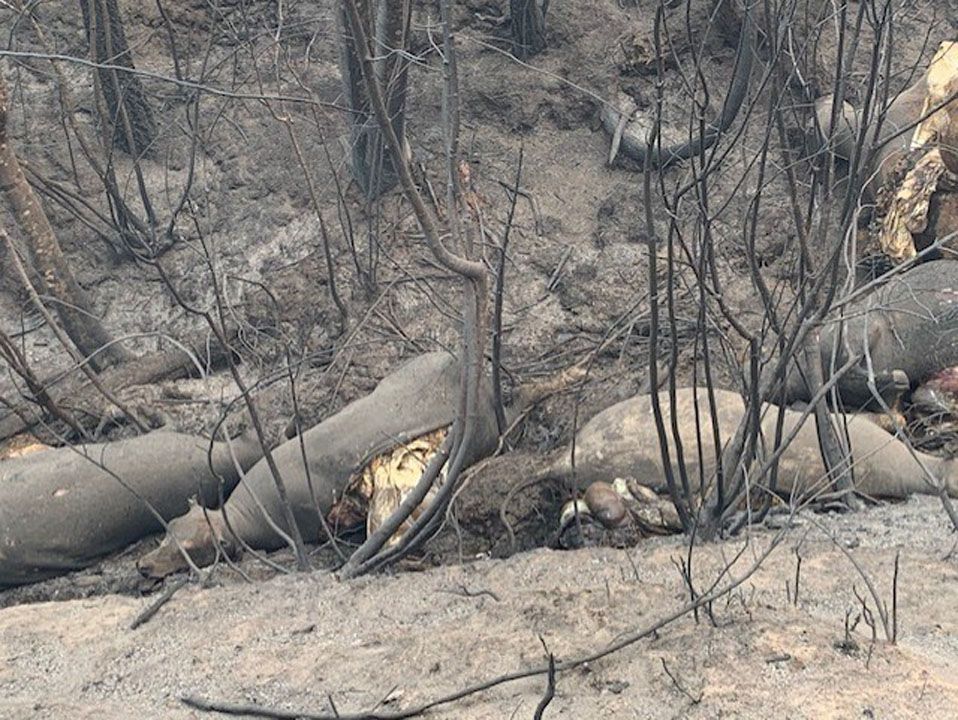Midweek Musings...Wants and Needs
Money still doesn't grow on trees... Our mission is public education as it relates to all things forestry

This is the second part in a two part letter by Dave Daley and his experience during the Bear Fire last summer. Part 1 can be found here.
Listen to the generations before. Mega-fires are a recent product of lack of use of fire, less grazing and over-regulation. And if you look at recent history, almost every mega-fire that I can recall has started on state and federal lands. Mismanagement. And those catastrophic fires contribute to climate change. Yet the guidelines followed by the feds on National Forest and the State on State Parks lands are “one size fits all.” It is beyond dumb. And no one’s fault. And everyone’s fault. Listen to the Forest. Listen to the locals.
The fire in Santa Rosa in 2018 was estimated to produce more CO2 and pollutants in one week than all of the cars in California in one year. We have already had six of the largest twenty fires in California history in 2020. The Bear Fire has eclipsed 250,000 acres and is still burning. To me this is very personal, but this is a much bigger problem than my family having our cattle killed.
I get frustrated with experts and consultants who drive by and “know just what to do.” For 35 years I have attended conferences, given presentations and listened. What I have learned is solutions are local and specific. What happens in one watershed in Plumas or Butte County may be entirely different in the Lassen National Forest just next door. But experts of all kinds are glad to tell you how to do it. “Let’s prescribe graze, use virtual fences, change your timing, change your genetics.” Prescribe graze the forest and canyons? Yea. Right. They don’t know what they don’t know but they will take the honorarium anyway and have a great dinner on your dime. Another game where the people who live here and the land rarely benefit.
I have traveled and given presentations nationally and internationally for decades as the odd “academic cowman.” I learned quickly that it is insulting to make suggestions if you don’t know the land, the people and the culture. I love these canned “you should do this and this” PowerPoint talks. It is frustrating. My approach has always been “this is what I do and why—it may not fit here so don’t force it.” I loved those trips not because of what I taught but of what I learned from the locals.
Cattle, like the wildlife, follow the season in this wildland we love. They start at low elevation in June and work east and higher until early October. As leaves begin to change, they start west and down. How and why would you fence this land? Again, an expert from afar who wrote a text or did it in a different ecosystem thought it was a great idea. It is exhausting.

Yesterday was day four of the recovery effort. I now understand what first responders mean when they say, “rescue to recovery.” I hold out little hope for live cattle. We have to get to Hartman Bar ridge between the middle fork and south branch of the Feather River. It is the furthest north, most breathtaking and the hardest to access. One road in and one road out, choked with downed and sometimes burning trees. We see a burnt bear cub trying to climb a tree, two miles further a mature bear, burnt but staying in the water trying to ease the pain. We give them both a chance because they made it this far. We don’t euthanize even though our brains say we should. Our hearts say let them try.
We have about six miles of road to make passable to get stock trailers through, but we make short work of it. Sometimes you can travel a quarter mile and sometimes a hundred feet. But chainsaws and strong hands get us there.
I have passed several streams today and tried to wade across one looking for cattle. It strikes me as strange. All the creeks have close to double the flow of last week. I see some springs running that haven’t been active for years. And it hits me. We have released the water that the brush was sucking from the land. The Native Americans were right again. Observe. Let nature talk.
We pulled up the grade to Hartman and Whiskey Hill, and there were cattle tracks in the burn! Lots of them. I couldn’t believe it. The fire roared up out of the middle fork so quickly I expected nothing to be alive. I had myself prepared. But we found cattle and some in pretty good shape. It was slow going. Incredibly steep and rugged with lost, hungry cattle. In one pocket we picked up 14 head with nary a scratch. Two old cows (12 plus years which is old for a cow) and a bunch of young stock. Those old ladies knew where to hide! Wisdom from days gone by.
After a long day, we had 32 alive and loaded. Some may not make it but we had to bring them home to give them a chance. They made it this far. More jarring, though, was to walk down the drainage by the old Mountain House Ridge corral and find 26 dead, spread from top to bottom. That fetid smell of death permeated the walk I used to love.
Even with the dead cattle on Hartman Ridge that we found, why did we find over half alive here and nowhere else? If anything, I assumed this steep ridge gave them no chance at all. And I realized that there had been a much smaller fire here about five years ago. The country was more open and the fire moved quickly. Less fuel and more things lived. Trees, wildlife, and cows.
I observed the same phenomenon in the remnants of the town of Feather Falls—where only a school and cemetery remain. The school had over 80 students less than 50 years ago, until the lumber mill closed and the village died. The school was destroyed by fire. The cemetery, however, still stands with green stately pines respecting the graves of mostly Native American veterans with flags at each grave. The cemetery was maintained free of deadfall and litter by family members. All the trees lived.
Day five begins.
We move as fast as we can, opening roads with saws and running 4-wheelers down every logging spur. We hope against hope for cow tracks but there are none. Hartman Ridge is about 10 miles long with the only narrow paved Forest Service road in the entire mountains. Nothing new but the cow tracks from those we found yesterday. Nothing at Socrates Spring, Harry Waite’s, the Lower Reservoir, DeJonah, Sheep Tank Meadow, Stag Point, Steward Ravine -- and a hundred more name places that are being lost. Nothing.
Up by Tamarack Flat, I run into five pick-ups belonging to timber reps from Sierra Pacific, the private land holder who we lease from and who has private property throughout our range. I am walking the logging road looking and listening, as I had run out of gas a mile or so ago. Too much country to cover! They were no doubt shocked to see me in that desolation striding down the road, covered in ash from head to foot. I know most of them. Foresters by trade who, like me, love the land. “It is all gone,” they say. Almost. I told them I could show them a few pockets where trees survived. But very few. We are sad and angry together.
By the end of a grueling day, we have 7 head loaded. Five of them are cattle we had seen before and were just able to get portable panels to and load, 3 of which are badly burned and will get a chance for feed and water before they will most likely die or need to be euthanized. We know of three more live cattle that we have seen and not loaded. That may be it. Over one hundred brought home, so far, but I will be surprised if eighty live. Many of those who live will have lost their baby calves to fire. There are no words. 20% of the herd we drove to the mountains on June 1st. Maybe.

Our crew will be smaller today. Rob flies back to his duty station in the army. Kate is back working as a veterinarian. They leave with overwhelming sadness and “we will help any way we can.” Most of the rest of our crew have to get back to their jobs, but “are a phone call away with a stock trailer” if we find something to load beyond the two trailers we will haul ourselves. I doubt we will. Kyle and I will start the search, compulsively walking creeks and canyons that we have already searched, hoping something straggles in behind. You never know and you can’t quit. That is not who we are.
And now we go on. What will happen? This is devastating emotionally and financially. And I am not sure of the next steps. I do know this: We must change our land management practices if we expect the West to survive. It is best done locally, not from DC or Sacramento, but I have tilted at windmills before.
We won’t quit. We need to get tougher and stronger. We never have quit for 140 years and I won’t be the first. Suffer the bureaucratic maze and try to make incremental change. And, as always, work with nature. I have to. Juni Daley, and the next generation, needs to see the mountains the same way we have seen them forever, to have hot chocolate on a cold fall morning and gather cows. It can’t be just stories from her Grandad.
We found an orphan heifer calf today, about two weeks old. Her mother didn’t make it. Kyle stumbled on her hiding in one of the few living willow patches along a stream. He followed her for over an hour straight up from the bottom of a canyon. We caught her and she is now on a bottle getting milk replacer. That rescue was good for my heart. My Granddaughter Juni’s first heifer I decide! They can grow up together.
We saw life at Fall River today. Green grass trying to sprout at a spring. Life is resilient. So are we. Next year. And the next 100.
Dave Postscript
It is day 12 and we still are at the same pace because we have no choice. We are finding one or two per day that have lived so it is difficult to stop, but that is dwindling so we have to shift our focus to those that lived. It is hard to do. We have put 1200 miles on the 4-wheelers on old logging roads and skid trails in the last few days. I quit counting the number of tires we have ruined and how much chainsaw work we are doing. Unfortunately, today we had to begin euthanizing some of the cattle that we brought home. But they were home, fed and watered.
The fire is still not contained and takes runs depending on the wind. I am not sure what next year will bring.
You 100% tax-deductible subscription allows us to continue providing science-based forestry information with the goal of ensuring healthy forests forever.